All object forms used for managing objects and events have the same structure and functions. Only the information included on the object forms varies depending on the object form. For this reason, each object form can only be used for managing the specific object related to the object form. For example, the Cable form is used for cables and the Poles is used for poles.
The functions of the buttons displayed at the bottom of object forms are always the same even though the information content of the forms may vary. In other words, the buttons always work in the same way for all network objects and on all forms. The buttons that are displayed depend on the user’s rights. If a button is dimmed, it is unavailable in that context. The button functions are introduced in the next chapters.

In addition to the buttons displayed at the bottom of an object form, some object forms contain additional functions that are used in the same way on all forms. Additional functions are used, for example, for adding dates or address information. These functions are discussed in the chapters Entering a date and Managing address and apartment information on object forms. The functions of buttons that are not introduced in this chapter are discussed in connection with the relevant object forms.
Favorite tools
Click Favorite in the top-right corner of the form to set the form in question as a favorite. User-configured favorites are displayed in the toolbar at the bottom of the map view, from where you can open them quickly. Future version updates may affect your settings concerning your favorites.
in the top-right corner of the form to set the form in question as a favorite. User-configured favorites are displayed in the toolbar at the bottom of the map view, from where you can open them quickly. Future version updates may affect your settings concerning your favorites.
You can also save the form’s search results as favorites:
- Retrieve the required information to the form, as instructed in the Retrieving information to a form and Picking objects from the map chapters.
- Click the Favorite button.
- You can enter a name for the search results in the Save new search dialogue box.
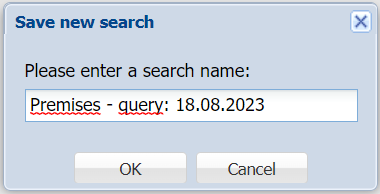
- Click OK.
- Your search results are now saved in the Favorites toolbar.

Deleting favorites:
Clear the form that you want to remove from your favorites. Click the Favorites button at the top. The program will ask you to confirm the deletion of the favorite.
OR:
Right-click the favorite in the bar at the bottom. The program will ask you to confirm the deletion of the favorite.
Note! By deleting the favorite, you delete the search result queries associated with the favorite.
Retrieving information to a form
To retrieve data on all objects to the form, first click  to clear the form and then click Search
to clear the form and then click Search  . If you want to retrieve data on some specific object types, you can specify the search criteria that are applied to your search. For example, if you want to retrieve all cables of a particular type, set the cable type to your desired type and click the Search button. The number of search results is displayed in the bottom left corner of the object form. If there is more than one result, you can browse through them with the arrow buttons
. If you want to retrieve data on some specific object types, you can specify the search criteria that are applied to your search. For example, if you want to retrieve all cables of a particular type, set the cable type to your desired type and click the Search button. The number of search results is displayed in the bottom left corner of the object form. If there is more than one result, you can browse through them with the arrow buttons 
 . You can enter values in any fields on the form or use a combination of fields to search for objects. If you want to browse through a large number of search results and update information related to some individual search result, the easiest way to do this is to use the List
. You can enter values in any fields on the form or use a combination of fields to search for objects. If you want to browse through a large number of search results and update information related to some individual search result, the easiest way to do this is to use the List  action (List view). Double-click a list view row to open the corresponding object form.
action (List view). Double-click a list view row to open the corresponding object form.
TIP: You can use % as a wildcard character to substitute text when carrying out a search. For example, instead of Kirkkotie, enter Kir% in the Address field to include all addresses starting with Kir in the search results. If you enter the character ! in a field, the search returns objects with that field empty.
Each object form has a Database ID text field. The database ID refers to the internal ID of each object. These IDs are automatically generated for each new object and they cannot be changed. This feature makes database IDs good identifiers because when using it, the user can be sure that an object is definitely the same even if its property attributes have been changed. Searching with the database ID works the same was as presented above.
Selecting multiple items
You can select multiple values from the same search field for your search. For example, the Premises form allows searching for multiple results based on values specified in the Type field. Hold the Ctrl key down and use the right mouse button to select the desired values in the Type field menu that you want to use as search criteria. The background of the selected values changes to blue. Click outside the field, and the values will be shown in italics, which means that they are included in the search. Click the Search  button.
button.

Searching by a date or number range
On some forms, you can search by a date or number range by double-clicking the field for a date or numeric value. When this function is activated, the original date field (or the field for a numeric value) is replaced with two new fields: the start and end values. Enter the relevant search criteria in these fields. When you click Search on the object form, all objects with their date (or numeric value) within the entered start and end values (including the entered values) are returned as search results.

Clearing an object form’s fields
You can clear the data in object form fields by clicking Clear  . This function clears the data in the fields, but it does not delete the data from the system. Clear the object form fields before conducting a new search, for example. When you click Clear, data on all searched objects for that form is deleted, not only the data related to the object that was displayed on the form. Any highlighting on the map is also removed.
. This function clears the data in the fields, but it does not delete the data from the system. Clear the object form fields before conducting a new search, for example. When you click Clear, data on all searched objects for that form is deleted, not only the data related to the object that was displayed on the form. Any highlighting on the map is also removed.
Default form values
You can view the default values for the object form fields by clicking Defaults  . Values are displayed if they have been entered in the system. Default values can include, for example, the most common property data for an object. The admin user can change the default values. When you add a new object, you can use the Default
. Values are displayed if they have been entered in the system. Default values can include, for example, the most common property data for an object. The admin user can change the default values. When you add a new object, you can use the Default  function to speed up the process of entering property values. You can also apply default values when you search a database.
function to speed up the process of entering property values. You can also apply default values when you search a database.
Updating object data
You can edit an object’s information on the form and update the information by clicking Save form  . For example, if you want to modify the usage state of some telecom premises and add information about the installation year, take the following steps: Open the required telecom premises on the Telecom premises form, go to the Usage state menu, and select In use. Then enter, for example, 2016 in the Install year field. Click Save
. For example, if you want to modify the usage state of some telecom premises and add information about the installation year, take the following steps: Open the required telecom premises on the Telecom premises form, go to the Usage state menu, and select In use. Then enter, for example, 2016 in the Install year field. Click Save .
.
Copying an object as a new object
You can create a copy of an object with the Save as copy function. This function creates a new object by using the same property values and location. We recommend using this function, for example, when the intention is to digitize several similar objects in the same place.

Mass update (Update all tool)
With Mass update, you can update data for multiple objects at one go. This function is useful in many situations when multiple objects need to be modified simultaneously.

For example, if you want to update the year 2016 as the installation year for all cables in the area, first retrieve information on all the cables in the area in question (area search) and enter 2016 as the value for Install year. Then, in the drop-down menu for Save form, click Update all.
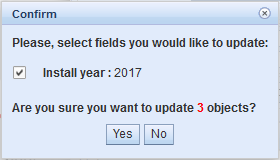
On the Confirm form, select the information that is to be updated for the objects if you have modified more than one form field. Click Yes to update 2016 as the installation year of the objects retrieved to the form.
Deleting objects and mass deletion
To delete objects from the system, retrieve an object through the form and click Delete  to open the Confirm dialog. The following dialog is displayed: Are you sure you want to delete this object? Click Yes to delete the object. This deletes both the property and location data of the object from the system. In other words, the object is no longer visible on the map and its information is deleted from the database.
to open the Confirm dialog. The following dialog is displayed: Are you sure you want to delete this object? Click Yes to delete the object. This deletes both the property and location data of the object from the system. In other words, the object is no longer visible on the map and its information is deleted from the database.
You can find an object for deletion by specifying the search criteria and by clicking Search  if you have knowledge of some key property value, such as Identification. If you know the location of the object, you can pick the object data from the map with the Pick
if you have knowledge of some key property value, such as Identification. If you know the location of the object, you can pick the object data from the map with the Pick  function.
function.
A Delete all function may be available to you depending on your user rights. This function is form-specific, and you can use it to delete more than one object at the same time. The Delete all tool is available in the drop-down menu for Delete. Delete all is available for objects that have no related dependencies to other KeyLight objects that would cause problems at the database level. The Delete all function will notify the user if an object group includes objects that cannot be deleted.

Locating and highlighting an object
Objects on the form can be located on the map by clicking Locate  . The map is centered on the object that is highlighted on the map. Objects can be located if an object’s geometry has been stored in the system and it is within the permitted coordinates.
. The map is centered on the object that is highlighted on the map. Objects can be located if an object’s geometry has been stored in the system and it is within the permitted coordinates.
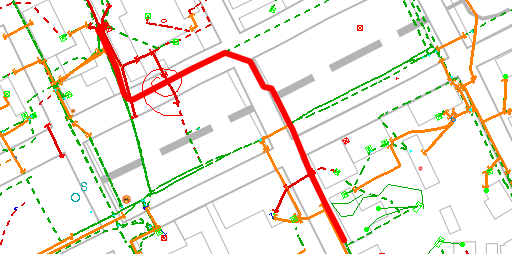
The drop-down menu for Locate also includes the following options: Zoom, Highlight, Zoom to all, Highlight all. These functions are introduced next.
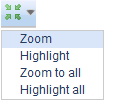
- The Zoom selection centers the map on the active object on the form. (Displayed only for objects that have a location.)
- The Highlight selection highlights the active object on the map, but the map view does not change. (Displayed only for objects that have a location.)
- The Zoom to all selection centers the map so that all objects retrieved to the form fit the map view.
- The Highlight all selection highlights all objects downloaded on the form, without changing the map view.
Picking objects from the map
To pick objects from the map, first click Pick from map  and then click a map object with the left mouse button. The object’s information is displayed on the form. You can only pick objects relevant for the form in question, that is, if you try to pick telecom premises to a form for splices, the following text is displayed at the bottom of the form: No matches found. If you are not sure which object is in question, you can use the Info
and then click a map object with the left mouse button. The object’s information is displayed on the form. You can only pick objects relevant for the form in question, that is, if you try to pick telecom premises to a form for splices, the following text is displayed at the bottom of the form: No matches found. If you are not sure which object is in question, you can use the Info  tool to specify the object and then open the correct form for that object from the list of results.
tool to specify the object and then open the correct form for that object from the list of results.
TIP: If you want to view the information related to an object whose type you do not know, you can use the Info tool. In the Info list that is displayed, click Modify to access the object’s form. For more information about the Info tool, see Info Tool.
Area searches
You can also pick the data for multiple objects at once. Click Pick  . Use the left mouse button to point at the starting point and hold down the mouse button until you have marked the area you want by drawing a rectangular. When you release the left mouse button, the information in the selected area is displayed on the form.
. Use the left mouse button to point at the starting point and hold down the mouse button until you have marked the area you want by drawing a rectangular. When you release the left mouse button, the information in the selected area is displayed on the form.
You can also select an area using the functions available in the drop-down menu for Pick  . Map view area retrieves the information on all objects in the map view. You can use the Free area function to select the required free-form area by placing points in required locations using the left mouse button. End the area selection by first clicking the left mouse button and then the right one. The search area is the area within the points you marked on the map.
. Map view area retrieves the information on all objects in the map view. You can use the Free area function to select the required free-form area by placing points in required locations using the left mouse button. End the area selection by first clicking the left mouse button and then the right one. The search area is the area within the points you marked on the map.
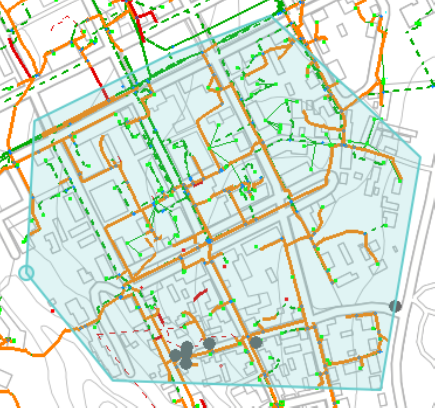
With the Existing area function, you can select a map area that has been created with the Area tool (Area, Plan, Service area, Exchange/Telecom area), in which case the search is carried out within the selected area.
If the object form fields are empty when the search is carried out, the search results will include all the objects for the form type. You can use search criteria to limit the search results. Enter the search criteria in the fields of the form and click Pick  . You can then select the Pick from map checkbox in the dialogue window that is displayed. Carry out a search as described above for area search functions.
. You can then select the Pick from map checkbox in the dialogue window that is displayed. Carry out a search as described above for area search functions.
For example, if you want to view the information on all cables installed in 2016 in a specific area, enter the search criteria on the Cable form, that is, enter 2016 in the Install year field. After you have defined the search area on the map, the number of search results is displayed in the bottom left corner of the object form. Use the arrow buttons  to browse through the search results.
to browse through the search results.
Modifying the geometry of an object
You can modify the geometry of the object on the form, that is, you can edit its location and form by clicking Modify . A Modifying dialog appears, in which you can select various settings related to modifying the object’s geometry. Update the geometry and click the Save
. A Modifying dialog appears, in which you can select various settings related to modifying the object’s geometry. Update the geometry and click the Save  button.
button.
Modification settings
In the settings for geometry, you can select the snapping point applied to a point that is moved while holding down the Shift key. Select Point for snapping if you want to move the point to the same location as some other point. Use Nearest if you want to position a point on top of the line of a line object, meaning the point moves to the nearest point on the nearest straight line.
Modifying the geometry of a line object
Line objects can be modified on the Cable, Conduit and Line forms. Select a line object on the map and open its form. Select Modify  to activate the function for modifying the geometry of the object. Alternatively, you can click on a line object on the map to use the Quick modify function.
to activate the function for modifying the geometry of the object. Alternatively, you can click on a line object on the map to use the Quick modify function.
Quick modify of a line object:
- Point at the required line object on the map and click the right mouse button while holding down the Control key. If the map object includes multiple objects, the Object selection window will be displayed. Click the required object with the right mouse button and select Modify
 .
. - Select the required options in the displayed Quick modify dialogue box.
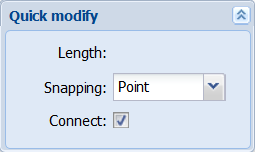
- Drag the points highlighted in red to the required location or remove them with the Delete key. You can snap to another object by holding down the Shift key while releasing the left mouse button.
- Click the right mouse button and click Save in the Confirm the move window to Save the changes. Cancel the changes by using the Cancel function.

You can use the pink squares to add points. You can move the squares in the same way as the existing points. Position your mouse pointer over a square, grab it while holding the left mouse button down and relocate the square. When you release the left mouse button, the square becomes a new point. In addition, new pink squares appear on the line between the new and existing points. These can be used to create further new points.
Splitting a line object
Line objects can be split using the Split function. This function highlights the selected object on the map and displays the Splitting dialogue box. This dialogue box displays the lengths of the parts to be split. These lengths are automatically updated based on the selected splitting point.
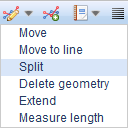
When a cable is split, it is possible to place a splice at the point of split. When a conduit is split, it is possible to place a manhole at the point of split. The cables in the conduit remain unchanged after the splitting.
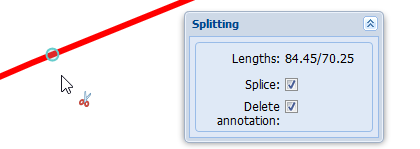
You can select one of the following as the split state in the menu:
Default: You can split a line object at a free location according to your choice.
Vertices: You can split a line object at one of its points.
Intersections: You can split a line object at an intersection. Another line object, such as a cable or conduit, crosses at the intersection.
Use the Delete annotation option to automatically remove annotations of a line object from the map.
Select the point where you want to split the object and click the left mouse button to accept the split. Both objects created through splitting are now displayed on the form. Use the arrow buttons  to browse through the objects.
to browse through the objects.
Extending a line object
A line object (cables, conduits) can be extended from the end that has not been connected. Activate this function in the drop-down menu for Modify  . The Drawing options dialog also appears. The functions of the Drawing options dialog are described in the chapter Snapping and following (settings for drawing and modifying).
. The Drawing options dialog also appears. The functions of the Drawing options dialog are described in the chapter Snapping and following (settings for drawing and modifying).
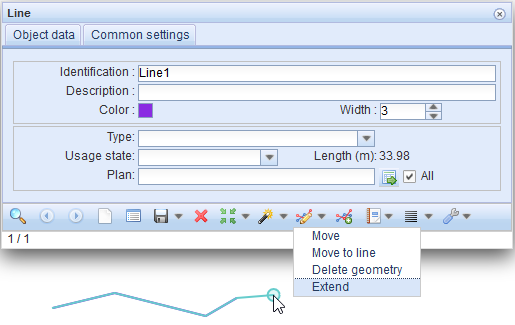
To continue the digitization of the object from its end point, create new points in required locations using the left mouse button. Create the end point of the object by first clicking the left mouse button and then the right mouse button. The object’s location and property values are automatically saved in the database.
Moving a line object to a line
You can move a line object to match the location of a linear geometry (or any other line object):
- In the drop-down menu for the Modify
 function on the form, select Move to line.
function on the form, select Move to line. - Select the required options in the Move to line dialog that appears.
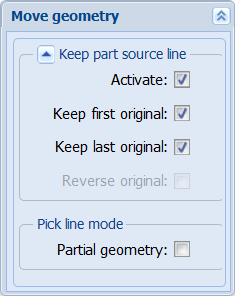
- Activate: With this option, you can maintain a part of the line’s original location, while another part is moved to a new target line. Activate the additional functions for the line that is to be moved:
- Keep first original: Keeps the first part of the line unchanged up to the point where you click the line
- Keep last original: Keeps the last part of the line unchanged from the point where you click the line.
- Reverse original: Reverses the order of the start and end points of the line to be moved
- Pick line mode: Partial geometry: You can choose a part of a route on both lines: the one you want to move and the target line.
- With the left mouse button, click the line to which you want to move an object.
- Stop the line selection by clicking the right mouse button. The new location of the object to be moved is highlighted in green.
- Accept the object move by clicking Save on the form or cancel the move by clicking Pan.
In the figure below, the Move to line function has been activated. The thin green line is the linear geometry. The thicker green line represents the new location of the object that is moved.

In the figure below the move has been accepted.

Moving a line object partially to a line
- In the drop-down menu for the Modify
 function on the form, select Move to line.
function on the form, select Move to line. - In the Move to line dialog, check the Partial geometry checkbox.
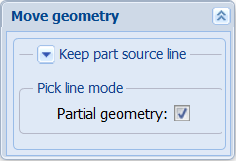
- Click the object to be moved on the map.
- Select the starting point on the target line (left mouse button). The selected starting point is shown as a blue box.
- Select the ending point on the target line(left mouse button).
- Repeat items 3–5 if you want the object to follow more than one line.
- Stop the line selection by clicking the right mouse button. The new location of the object to be moved is highlighted in green.
- Accept the object move with Save or reject it with the Pan button.

Mass movement of line objects
In the drop-down menu for the form’s Modify  function, select Move all to line to activate a mass transfer. Note that more than one line object must be retrieved to the form to make mass movement possible. Take same actions as when moving a line object, as explained in the chapters Moving a line object to a line and Moving a line object partially to a line.
function, select Move all to line to activate a mass transfer. Note that more than one line object must be retrieved to the form to make mass movement possible. Take same actions as when moving a line object, as explained in the chapters Moving a line object to a line and Moving a line object partially to a line.
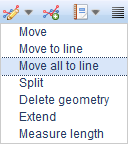
Moving a line object
You can move a line object on the map either freely by dragging it using the left mouse button or relatively by specifying the distance from the original location.
In the drop-down menu for the Modify  function on the form, select Move. The object is highlighted on the map and a Move dialog is displayed, in which you can select the Mode of movement.
function on the form, select Move. The object is highlighted on the map and a Move dialog is displayed, in which you can select the Mode of movement.
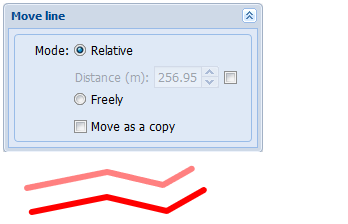
Select Relative to move an object horizontally or vertically for the number of metres displayed in the Distance field. Click the left mouse button to accept the location and click Save form to save it.
Select Freely to move an object by positioning your mouse pointer over the red square and move the object to a new location while holding down the left mouse button. Release the left mouse button. Click Save form on the form to save the new location.
Checking the Move as a copy checkbox makes it possible to copy the object to a new location.
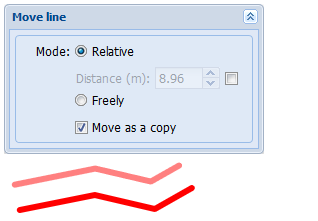
Modifying the geometry of a point object
Modifying the location of a point object, such as a pole, is carried out in the same way as for line objects, the only difference being that there is only one point. Click Modify  to highlight the modified object on the map. When you position your mouse over the object, the mouse pointer changes from an arrow to a cross. Click the object with the left mouse button and hold the button down while moving the object to a new location. Release the mouse button. Click Save form
to highlight the modified object on the map. When you position your mouse over the object, the mouse pointer changes from an arrow to a cross. Click the object with the left mouse button and hold the button down while moving the object to a new location. Release the mouse button. Click Save form  to save changes.
to save changes.
For some point objects, such as telecom premises, any objects connected to them can also be moved. The modification dialogue box for such objects includes a Move connected checkbox. If this Move connected checkbox is selected, any objects connected to the point object will also be moved. In addition, you can connect a point object, such as Telecom premises, when you make modifications.
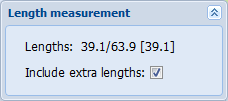
The quick modify function of a point object:
- Point at the required point object on the map and click the right mouse button while holding down the Ctrl key. If the map object includes multiple objects, the Object selection window will be displayed. Click the required object with the right mouse button and select Modify
 .
.
Select the required options in the displayed Quick modify dialog box.
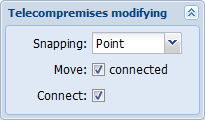
Drag the red square to the required location. You can snap to another object by holding down the Shift key while releasing the left mouse button.
Click the right mouse button and click Save in the Confirm the move window to save the changes. Cancel the changes by using the Cancel function.
Rotating a point object
For a point object, you can set a new rotation angle via Rotate in the Modify  drop-down menu. Click the Save form button to save the new rotation angle of the object.
drop-down menu. Click the Save form button to save the new rotation angle of the object.

A blue cross appears on of the object you are editing. The cross indicates the angle of rotation of the object. Rotate the object by grabbing the  symbol.
symbol.
When you click Rotate, the Rotate window is displayed, where you can enter the required angle. You can specify the steps as degrees. If Steps is selected, the rotation angle of the selected object changes in steps when you rotate the object. Use this feature to rotate an object in steps of, for example, 45 degrees. Angle displays the rotation angle of the object. Click Save form on the form to accept the rotation angle. If you do not want the object to have a rotation angle, cancel it with the right mouse button.
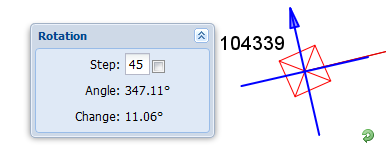
Modifying the geometry of an area
You can modify the geometry of an Area (Area, Plan, Exchange area) by clicking Modify  on the object form. The points of the area are highlighted. Drag the points with the left mouse button. To create a new point, click the light-red square in the middle of a straight line and drag it to a new location. Click Save form
on the object form. The points of the area are highlighted. Drag the points with the left mouse button. To create a new point, click the light-red square in the middle of a straight line and drag it to a new location. Click Save form  to save the changes.
to save the changes.
Quick modify function of an area object:
- Point at the required area object on the map and click the right mouse button while holding down the Ctrl key. If the map object includes multiple objects, the Object selection window will be displayed. Click the required object with the right mouse button and select Modify
 .
. - Select the required options in the displayed Quick modify dialog box.
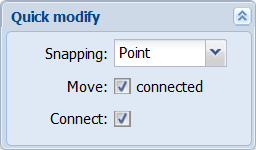
Drag the points highlighted in red to the required location or remove them with the Delete key. You can snap to another object by holding down the Shift key while releasing the left mouse button.
Click the right mouse button and click Save in the Confirm the move window to save the changes. Cancel the changes by using the Pan  function.
function.
Digitizing a hole in an area object
- In the drop-down menu for Modify
 , select Make a hole.
, select Make a hole.
- Within the highlighted area, draw a hole that has the required shape.
- When you stop drawing, the form is saved and the hole has been created.
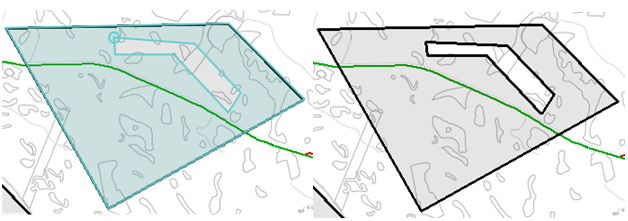
Removing a hole in an area
- On the Area form, in the drop-down menu for Modify , select Remove a hole.
- Click the hole you want to remove.
- Confirm the removal.
Deleting the geometry of an object
You can click Delete geometry in the drop-down menu under the Modify  button. This function deletes the geometry of the selected object making the object disappear from the map. The property data for the object is not changed.
button. This function deletes the geometry of the selected object making the object disappear from the map. The property data for the object is not changed.

Creating a new object
Create a new object by specifying its location, that is, its geometry. Click Create new to do this. Always select the correct object form. For example, use the Cable form to create a new cable, and the Pole form to create a new pole. You are usually required to provide at least some mandatory information on the form before you can create an object. You can add other object data either before or after creating a new object. Save the object data by clicking Save
to do this. Always select the correct object form. For example, use the Cable form to create a new cable, and the Pole form to create a new pole. You are usually required to provide at least some mandatory information on the form before you can create an object. You can add other object data either before or after creating a new object. Save the object data by clicking Save  .
.
Click the Create new  button to open the Drawing options form. The functions of this window are described in the chapter Snapping and following (settings for drawing and modifying). In general, line objects have more drawing options than point objects. Once you have created a new object, you can update it with property information on the form. The property information that you add to an object varies somewhat depending on the object and its form. The property information is updated with the Save
button to open the Drawing options form. The functions of this window are described in the chapter Snapping and following (settings for drawing and modifying). In general, line objects have more drawing options than point objects. Once you have created a new object, you can update it with property information on the form. The property information that you add to an object varies somewhat depending on the object and its form. The property information is updated with the Save  button.
button.
Creating a new line object
Start creating the geometry of a line object by clicking the required starting point on the map using the left mouse button. Next, digitize the required points one by one by clicking the left mouse button at the relevant locations. Finally, end the digitization by first clicking the left mouse button and then the right mouse button. The object’s location and property values are automatically saved in the database. You can select the Connect checkbox, for example, to automatically connect a cable to premises. Connecting cables is discussed under Connecting cables.
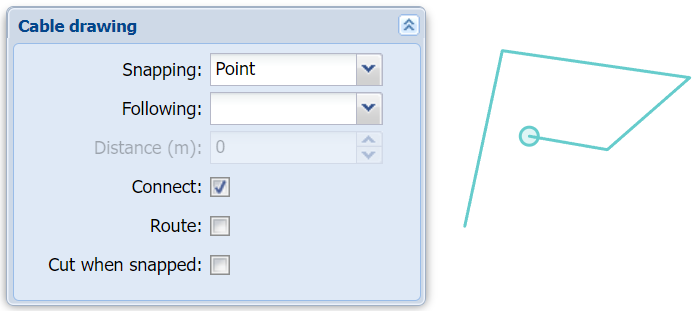
The drawing settings for line objects include the option Following. You can use this function, for example, when you digitize a cable to go through a conduit. When you have selected the option Completely for Following, point at the starting point of the conduit to have the line object you create follow through all the points of the conduit and to continue digitization from the ending point of the conduit. However, if you want to follow the conduit only partly, you can select the Following option Partially. This lets you follow the conduit to the required point, after which you can continue digitizing freely. If you want to follow an object in parallel at a specific distance, specify Distance in the drawing settings.
Creating a new point object
A point object is created by specifying one point on the map where the object is created. Create a new point object by clicking the left mouse button at the required location on the map. The program automatically saves the geometry of the object in the database. If saving succeeds, the following text is displayed at the bottom of the object form: Saved successfully. The object’s location and property values were saved in the database. The rotation function for a point object is activated immediately after the object has been created. A blue cross symbol appears over the object, indicating the rotation angle of the object. If you want to modify the object’s rotation angle, grab the  symbol using the left mouse button and rotate it to the required angle.
symbol using the left mouse button and rotate it to the required angle.
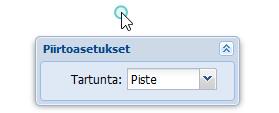
An object can also be placed on the map based on coordinates. First, deselect the Coordinate reading on/off checkbox in the bottom-right corner of the map view and enter the coordinates for the required location. Then, click the  button to create a new object on the map in the desired location. Save form.
button to create a new object on the map in the desired location. Save form.
Creating new objects by using existing objects
You can create new objects based on the location of and information of existing objects.
Retrieve an object’s information to the form, for example, by picking an object from the map. After this, either
1. Click Create  to create a new object based on the object information retrieved to the form. The program calculates the length of a line object based on the geometry of the new object.
to create a new object based on the object information retrieved to the form. The program calculates the length of a line object based on the geometry of the new object.
OR
2. In the drop-down menu for Save form , click Save as copy. A copy of the active object is saved on top of the existing object. This is a useful function, for example, when the same location is used for saving several cables.
, click Save as copy. A copy of the active object is saved on top of the existing object. This is a useful function, for example, when the same location is used for saving several cables.
Related tasks
An object may have related tasks. Check the status of the object’s tasks by hovering over Tasks  with the mouse. The tooltip indicates the number of tasks and the number of unfinished tasks. The Tasks
with the mouse. The tooltip indicates the number of tasks and the number of unfinished tasks. The Tasks feature can be found in the menu under the Tools
feature can be found in the menu under the Tools button.
button.

Adding a task for an object
- Open the task list for an object by clicking Tasks
 .
. - Click
 Add task to open the Task form with the Parent object information pre-completed on the form.
Add task to open the Task form with the Parent object information pre-completed on the form. - Fill in the form fields. Type, Task state, and Count are mandatory fields.
- Click Save form
 on the object form to save tasks. The task list for the object is updated with the new task.
on the object form to save tasks. The task list for the object is updated with the new task.
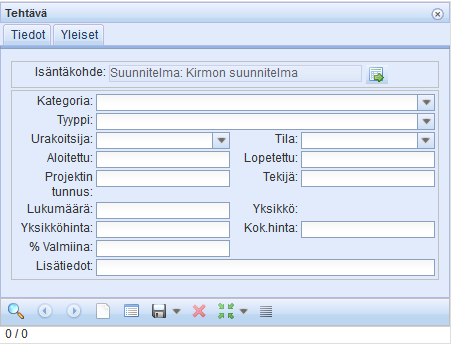
The Task form is discussed in more detail in the Tasks chapter.
List view
Many object forms include a List button. You can use it to view the search result objects in a list view. You can use this function to quickly browse through objects. The number of objects displayed on one page can be modified using the Per page selection. Use the arrow buttons to navigate the pages.
button. You can use it to view the search result objects in a list view. You can use this function to quickly browse through objects. The number of objects displayed on one page can be modified using the Per page selection. Use the arrow buttons to navigate the pages.
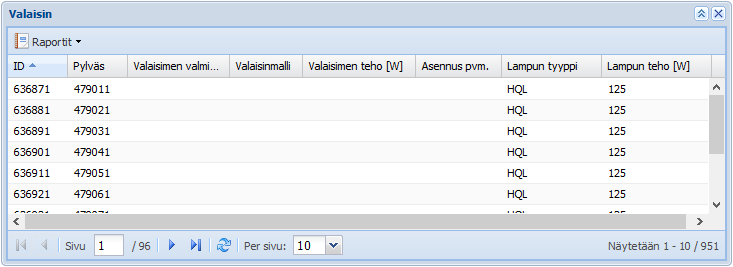
To view the tools related to the list, hover your mouse pointer over a header field. This displays a menu in the selected field  .
.
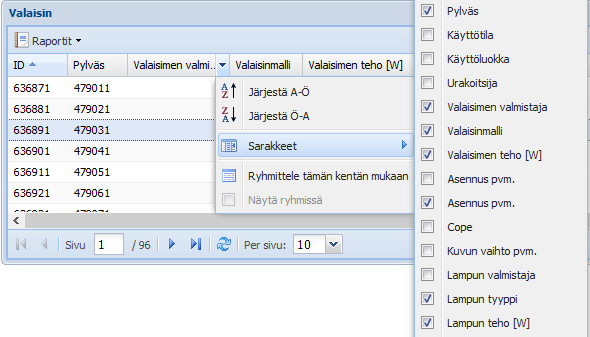
The menu includes an option for sorting the list based on the selected field either in ascending or descending order. The Columns function lets you select the columns that are displayed in the list view. The lists include the typical information for the object type as default data. The Group by this field function groups the list contents based on the selected field. The grouping can be cancelled by deselecting the Show in groups checkbox in the drop-down menu.
You can open a listed object displayed on the form by clicking the object with the right mouse button and selecting Edit selected.
You can use the Reports function to create an Excel list report on the listed objects. The report includes the same information as the list.

Show in group display
In the drop-down menu for List  , select Show in group display to move the current search results from the form to a group display. Group displays are discussed in more detail in the chapter Group display.
, select Show in group display to move the current search results from the form to a group display. Group displays are discussed in more detail in the chapter Group display.
Change history
To view the change history of the object on the form, click Change history  in the drop-down menu for Other tools
in the drop-down menu for Other tools  . The top section of the displayed form lists the various object versions, while the bottom section displays the changes made to the selected version.
. The top section of the displayed form lists the various object versions, while the bottom section displays the changes made to the selected version.
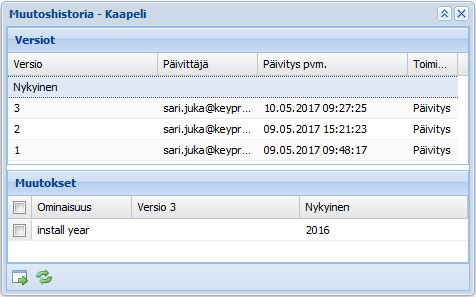
Restoring the values of an object
- In the Versions section, select the row that you want to restore.
- In the Changes section, select the checkboxes for the rows that you want to restore.
- Click Restore
 to update the selected information on the object form.
to update the selected information on the object form. - Click Save
 on the object form to confirm the changes.
on the object form to confirm the changes.
Comparing object versions
In the Versions list, select the rows for comparison to see, in the Changes list, the current version in addition to the selected versions.
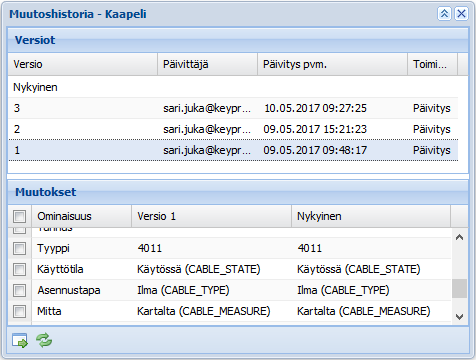
Reports
Reports  can be created on forms and lists. Creating a report on objects that are included in a list of search results is discussed in the chapter List view. Report generation is available in the Export
can be created on forms and lists. Creating a report on objects that are included in a list of search results is discussed in the chapter List view. Report generation is available in the Export  drop-down menu. You can create various types of reports in the system. The information on the search results displayed on the form is used to create a report. You can save the report as a file or open it directly in Excel.
drop-down menu. You can create various types of reports in the system. The information on the search results displayed on the form is used to create a report. You can save the report as a file or open it directly in Excel.

Asynchronous reports
When reports are created for a large number of search results, reporting is carried out asynchronously, that is, in a reporting mode that is run in the background when report creation exceeds the time limit specified for the environment in question. Typically, this time limit is defined to be one minute. The report will then be sent as an attachment to the email address specified for the username. The program will notify the user if the report has been sent to the user by email.
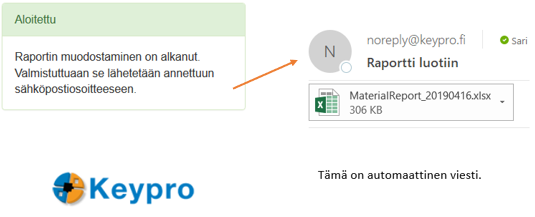
Customer-specific reports
KeyLight enables the creation of customer-specific reports if this function has been ordered separately. With the help of Keypro’s experts, the admin user interface is used to create a Report group that configures the fields to be displayed in the report and the applicable search criteria.
Customer-specific reports are available in the Reports menu in the main toolbar. A report is processed in the background and sent to the user's email.
menu in the main toolbar. A report is processed in the background and sent to the user's email.
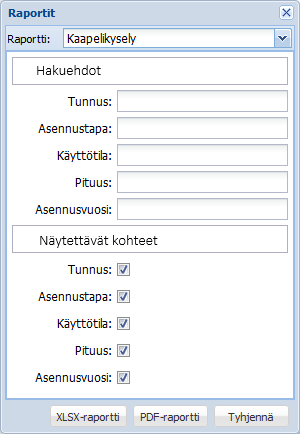
Entering a date
Object forms may include date as a property attribute that can be used, for example, to specify when a survey was carried out. Adding a date has been standardized using the calendar, making sure that the same format is always used when dates are entered in the database. This also allows for using it as a search criterion.
Hover the mouse over the Date field and click the left mouse button to open the calendar menu. The current date is selected as default. You can browse through months using the arrow buttons at the top of the calendar window. You can browse through years by clicking the year at the bottom. To select a date, click a day using the left mouse button. The selected date is displayed in the Date field.
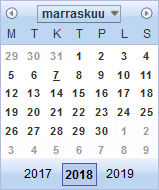
Managing address and apartment information on object forms
To add address information on an object form, retrieve the information from the database or use the Autom. option. When addresses are retrieved from a database, addresses contain no spelling errors and they can be used as one search criterion.
Click Address  on the object form to open the Address form. If an address has already been added for the object, the Address form displayed contains that address as a default address. If an address has not been added for the object, the Address form displayed contains no information. When you search for an address in the database, you can use the following search criteria: street name, unit number, zip code, or parts thereof, with % used as a wildcard character. Click Search
on the object form to open the Address form. If an address has already been added for the object, the Address form displayed contains that address as a default address. If an address has not been added for the object, the Address form displayed contains no information. When you search for an address in the database, you can use the following search criteria: street name, unit number, zip code, or parts thereof, with % used as a wildcard character. Click Search  to start your search. The search function has been described in more detail in the chapter Searching for addresses.
to start your search. The search function has been described in more detail in the chapter Searching for addresses.
Use the arrow buttons to browse through the search results. When the correct address has been found, you can import it to the object form from which the Address form was opened. Click Update to form  to do this. You can also locate an address on the map by clicking Locate
to do this. You can also locate an address on the map by clicking Locate  to center the map on the address location.
to center the map on the address location.
Automatically adding an address works when the Autom. check box is checked and you click the Save button. The nearest address is used and the distance to the nearest address is displayed at the bottom of the display.

Using the predictive search field
Some forms have a predictive search field that is used for connecting one object to another object, such as to an Area or a Plan.

- Enter at least the first three characters of a name/identifier in the search field.
- From the displayed search results, select an object or continue typing to limit the number of options.
If you do not know the name/identifier:
- Click Open form
 to open the object form.
to open the object form. - Retrieve the correct object to the form by clicking Search
 or Pick from map
or Pick from map  .
. - When the correct object is displayed on the form, click Update to form
 .
.
Free-form property attributes
If some free-form property attributes have been added to an object form, the form includes an Extra data tab where such information can be viewed.

You can use the free-form property attributes when searching for objects, and they can be included in the List function and the related report. The admin user of the system can freely configure the free-form property attributes, name them, and select the data type to be applied (text, figure, date).